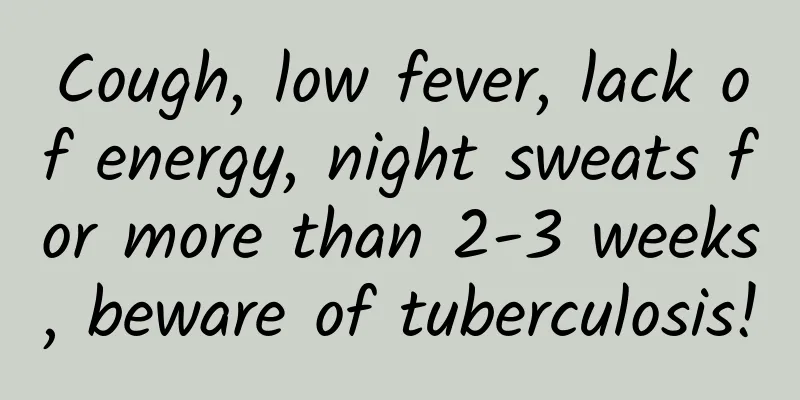Cough, low fever, lack of energy, night sweats for more than 2-3 weeks, beware of tuberculosis!

|
Author: Chen Xiaoyou, Chief Physician, Beijing Ditan Hospital, Capital Medical University Standing Committee Member of Tuberculosis Branch of Chinese Medical Association Reviewer: Liu Xinmin, Chief Physician, Peking University First Hospital On March 24, 1882, German scientist Robert Koch announced to the world that the clear causative agent of tuberculosis is Mycobacterium tuberculosis, and its scientific name is Mycobacterium tuberculosis. To commemorate this great scientist, March 24th of each year is designated as World Tuberculosis Day. Tuberculosis is a systemic disease, and pulmonary tuberculosis is a type of tuberculosis, accounting for a large proportion. In China, about 80%-85% of tuberculosis is pulmonary tuberculosis. 1. What kind of disease is tuberculosis? Tuberculosis is a disease with a long history. Whether it is Chopin and Chekhov from abroad or Lu Xun and Lin Huiyin from China, they all suffered from tuberculosis. From a medical point of view, tuberculosis is an infectious disease because it is caused by infection with Mycobacterium tuberculosis. Figure 1 Original copyright image, no permission to reprint If we are exposed to an environment with Mycobacterium tuberculosis, everyone will be infected and no one can escape it. However, among people infected with Mycobacterium tuberculosis, approximately 1/20 to 1/10 of them will develop the disease in their lifetime. That is to say, if 20 people are infected, one or two of them may develop the disease in the future. This is the incidence data for the entire population. For some special groups of people, such as those suffering from diabetes, tumors, or long-term use of hormones, immunosuppressants and other drugs, they are more likely to develop the disease after being infected with Mycobacterium tuberculosis. At the same time, tuberculosis is also an infectious disease. If a patient with the tuberculosis virus speaks loudly or coughs, droplets containing tuberculosis bacteria will be produced in the air. The droplets spread in the air. If the distance is relatively close and the environment is relatively closed, we will inhale the tuberculosis bacteria into the lungs through breathing, which will lead to infection. Figure 2 Original copyright image, no permission to reprint Because tuberculosis can be transmitted from person to person, it has attracted widespread attention from society. Therefore, the "Law on the Prevention and Control of Infectious Diseases" clearly classifies it as a Class B infectious disease and manages it accordingly. Before the discovery of the anti-tuberculosis drug streptomycin in the 1940s, the tuberculosis epidemic was very serious. About nine out of ten people who got sick faced death, so we called it the "white plague" or "nine out of ten people with tuberculosis died." Therefore, before the emergence of anti-tuberculosis drugs, the treatment method was mainly based on the sanatorium model because there was no medicine available. Let the patient get more sun and breathe more fresh air, which is the best way of treatment or recuperation. With the advent of anti-tuberculosis drugs, the situation of tuberculosis has been significantly reversed and the epidemic has been well controlled. However, according to a report from the World Health Organization (WHO), about 1/3 of the world's population is infected, and because 5% to 10% of them will eventually develop the disease, the situation is still quite serious, so we still need to continue to pay attention to it. 2. What symptoms should make you highly alert to tuberculosis? Tuberculosis includes pulmonary tuberculosis and extrapulmonary tuberculosis. They have similar symptoms. The most common one is fever, which we call afternoon fever. The period after lunch and before dinner is called afternoon. Patients often have low fever. Generally speaking, the body temperature will not exceed 38.5℃, or even below 38℃. The second symptom is fatigue, which is what we usually call a lack of energy all over the body. You feel very tired in work, study, and life. There is also a condition called night sweats, which means that we sweat all over our body after falling asleep. When we wake up, some people will find that their clothes are wet with sweat, and even their pillowcases and quilts are wet. This condition is called night sweats. Some patients will also lose weight. Because it is a wasting disease, Mycobacterium tuberculosis absorbs nutrients from the human body, so patients with pulmonary tuberculosis will also gradually lose weight. Some patients may also have some erythema on their arms and legs, and some may even have conjunctivitis in their eyes. These are all systemic manifestations of tuberculosis, and these symptoms are not very common. Figure 3 Original copyright image, no permission to reprint Generally speaking, the common symptoms of tuberculosis are fever, fatigue, night sweats, and weight loss. Since pulmonary tuberculosis occurs in the lungs, it also has some special lung symptoms, such as coughing, sputum, hemoptysis, chest pain, and dyspnea. In addition, a characteristic of cough caused by tuberculosis is that it often lasts for 2 weeks or even more than 3 weeks. Therefore, if the coughing symptoms last for more than 2 weeks or even 3 weeks, we should be alert to the possibility of tuberculosis. Such patients must go to the hospital for examination in time, and actively diagnose under the guidance of professional doctors. Once diagnosed, timely treatment should be given to avoid delaying the disease! |
Recommend
How long does it take to get menstruation after miscarriage?
Having a child is a major event in a woman's ...
Which period of pregnancy is the most difficult?
The first three months of pregnancy are a dangero...
Is it harmful to take painkillers for dysmenorrhea?
In daily life, many women suffer from menstrual p...
I feel hungry quickly during breastfeeding.
When we are very hungry, we will want to eat, but...
Is urine pregnancy test accurate at night?
If an adult woman has sex without taking any cont...
Is it possible to get pregnant if you stay up late every day?
Staying up late often is a behavior that is more ...
Tumor-associated hyperprolactinemia, common pathogenic factors
There are many causes of hyperprolactinemia, and ...
How long does the temperature rise during pregnancy last?
During the early stages of pregnancy, women will ...
How to abort a three-month-old fetus
We all know that when a woman is pregnant, if she...
Toothpaste can "fight Helicobacter pylori"? Don't be fooled!
[This issue's rumors]: "Medical-grade to...
One dark and one blurry test paper
We should have some basic knowledge about early p...
Can I get pregnant with an IUD?
Contraception has always been an issue of concern...
Reasons for loss of appetite during pregnancy
Maternal love is the greatest thing in the world....
Can pregnant women eat watercress?
What food pregnant women can eat is actually an i...
How harmful is pelvic inflammatory disease?
There are many patients with pelvic inflammatory ...









